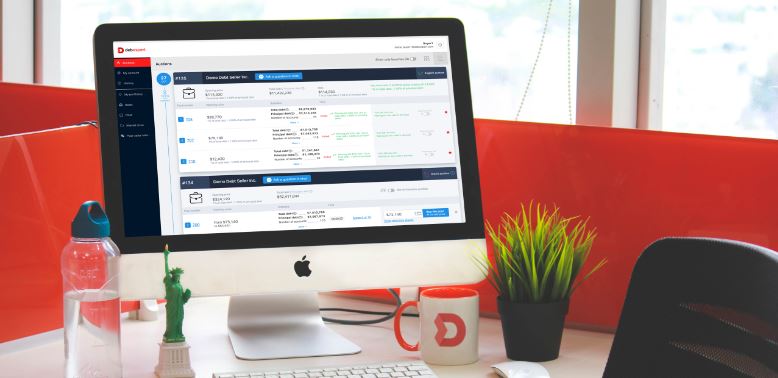
Today, the online sale of debt looks like a very attractive direction for our industry. At first glance, everything really becomes simpler and more intuitive. Online services remove a lot of routine operations from us. But as in any new business, there are a number of important points that both the seller and the buyer need to pay attention to when concluding online transactions. After all, no online platform can save us from the responsibility of the results of our work.
Best practices for a secure online bidding platform
There are two models of online debt trading. Let’s call the first one the classified model. It was formed quite a long time ago and is known to many of you. Portfolios are located on the websites of debt brokers or independent companies, for which their owners are waiting for feedback from potential buyers. All of this is like selling a product on classic platforms, like Amazon. Sooner or later, there will be a client who will offer a price that suits the seller. I would highlight two disadvantages of this model. The first is that the term of realization of the portfolio on such sites may be delayed due to the complexity of its search on the internet. The debt buyer must find the right product, which can be hidden on one of the sites. But where to look for it exactly? The second problem is related to the fact that the seller of the portfolio will receive the price that the debt buyer, who eventually discovered the portfolio on the internet, will offer him.
The second type of online auction sale is the auction model. It began to form a few years ago. As the name suggests, its essence is the sale of a portfolio through an auction. As a rule, three types of auctions are used for the sale of debts: an English auction (a classic auction for raising rates), a Dutch auction (lowering rates from the maximum price), and a sealed bid (an auction for the products that have a limited interest of buyers). The auction model has a number of advantages. For lenders, this is primarily a high speed of selling a portfolio. Usually, it is no more than two weeks. The second advantage is obtaining a real market price because the competition among buyers makes the final price of the portfolio move up. If we talk about debt buyers, they can always find a relevant portfolio in one place – there is no need to waste time searching. The second advantage is access to small portfolios that any buyer can buy. Given that the auction model of selling debts is only gaining popularity, in this article, I will focus on it.
How the process works
It is important that readers understand how the whole process works. So, the debt seller (it can not only be the bank, but also the debt buyer, who decided to get rid of part of his portfolio) is registered on the online platform. The next step is to publish a portfolio on the site, in which sensitive parameters are hidden. This is personal data of account or some other parameters that the portfolio owner would not like to show at this stage. The publication of the portfolio allows potential buyers to conduct a preliminary assessment, on which the final price depends. As a rule, an auction is held a week or two after the publication of the mask file. Usually, its duration is no more than an hour. If the final price of the pool suits the seller, you can proceed to the execution of the transaction.
Before the portfolio is available for due diligence by buyers, the seller is checked for a variety of parameters to ensure the safety of buyers.
The main points that are checked by the sites: accuracy and completeness of the information provided by the client in the masked file, so that buyers can conduct a full assessment, chain of title (if the seller is not an originator), the minimum required set of documents for transfer to the buyer, correctness of filling in the Sellers Questionnaire, adverse litigation and/or consent orders, the volume and nature of consumer complaints filed with the CFPB’s consumer complaint system and the BBB, adverse information concerning principles, the reputation, experience, and other parameters.
After a full verification is carried out, the information is published on the sites and becomes available to buyers for evaluation and verification.
Data protection
Any online platform is interested in protecting data. Pay attention to the encryption methods used by the platform. If end-to-end encryption of the entire file sharing is used – there is nothing to worry about. Even intercepting a file protected this way will not lead to any losses, simply because it will take 10 or more years to decrypt it.
Checking potential buyers
Usually, online platforms are extremely serious about checking debt buyers. The submitted documents are checked, the availability of appropriate licenses of the buying company (in some states) and collect delinquent debts, reviews on state bases CFPB and BBB, possible Consents Order or a ban on doing business. The internal policies related to the collection activities and compliance with the FDCPA, data protection is also viewed. Online negative news search is also important in buyers’ due-diligence not only on the company but the owners as well. Prior purchasing history and experience, as well as peer references, are good sources to do additional validation.
It is important to mention that the verification of debt buyers is carried out on a regular basis – not only at the connection stage but also after the debt buyer becomes a full-fledged bidder. According to the results of the check, the online platform may refuse to register the debt buyer.
Online bidding process options
As I said earlier, three types of auctions are usually used for the sale of delinquent debts – English, Dutch, and sealed bid. All portfolios are unique, so the approaches to selling them may differ. In this sense, consultation with the employees of the online platform can be invaluable. Based on their experience, they can recommend the best-selling strategy: split the portfolio into pools to increase the interest in the portfolio among special groups of buyers, or set a time for sale when there is maximum liquidity in the market, choose the right type of auction, the bid step, and other important parameters.
A very important point is the communication between the debt seller and the buyers. Very often, established relationships lead to the earliest closing of a deal on the best terms. Therefore, you should not neglect the opportunities for communication before the auction.
In addition, some sites offer powerful analytical capabilities, including analysis of trades, monitoring, or participating, in them via mobile devices. Understanding the technical or functional capabilities of the site gives advantages to bidders.
Closing the deal
At the end of the auction, the winner is revealed. As I’ve said before, the debt seller can agree with the final price. In this case, everything is quite simple – after confirmation, both companies conclude a deal. However, if the debt seller considers that the final price is low, they may refuse to sell at all. In addition, the auction can be restarted on another day or they can change the auction type. Employees of the online platform usually offer several solutions.
This is a very important point that I would like to draw your attention to. Winning an auction does not automatically mean getting a portfolio. The seller may refuse to sell if the winning company does not pass the verification.
Most sites have purchase sale agreement templates that they can recommend to the seller and buyer, as well as help with data transfer.
Transferring the final file, etc.
Usually, one or two weeks after the auction ends, the contract between the seller and the buyer is signed. Both of the sides discussed the method and timing of the transfer of the main data. I recommend that all electronic documents be transmitted inside the site in encrypted form – this is much more reliable. However, this is just a recommendation, not a necessity.
It is very important for a debt seller to prepare the documents for the sale in advance because any debt buyer would like to launch a new portfolio as soon as possible. Systematic delaying of the transfer, or incompleteness, has a very bad effect on the economic indicators of the buyer and as a result, on the desire to participate in subsequent transactions with the debt seller. All risks and additional costs will be taken into account by the buyer during the next auction.
If potential debt sellers or buyers have any questions regarding online sales, I am always ready to help. Please feel free to contact me directly at ivan@debexpert.com.
Best Practices of Debt Sales












Facebook Comments